Die Inhalte dieser Seite sind leider nicht auf Deutsch verfügbar.
Seitenpfad:
Cryodinium meridianum
Zonneveld, K.A.F. and Pospelova V. (2015). A determination key for modern dinoflagellate cysts. Palynology 39 (3), 387- 409.
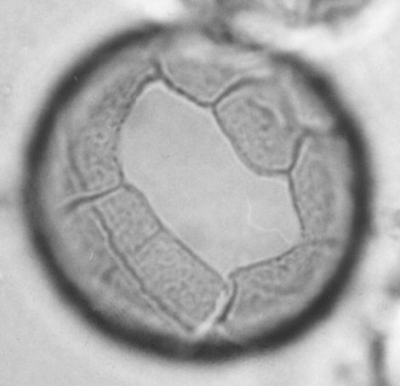
Photographs by Oliver Esper
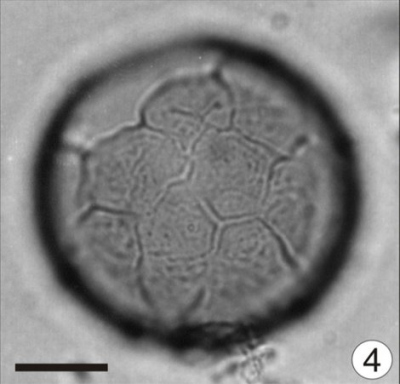
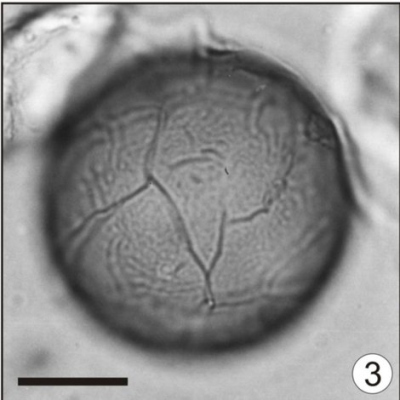
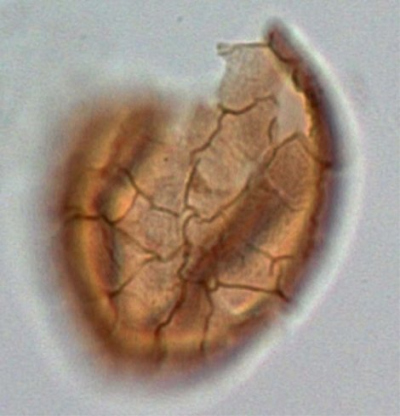
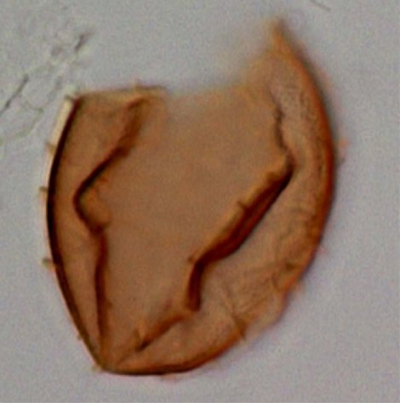

dorsal view
Sample: PS2366-2, EFC: L34/3
Southern Ocean, Atlantic Sector
photographs: Karin Zonneveld
Sample: PS2366-2, EFC: L34/3
Southern Ocean, Atlantic Sector
photographs: Karin Zonneveld
dorsal view
cross section
Sample: PS2366-2, EFC: N35/1
Sample: PS2366-2, EFC: N35/1
Field characteristics
Cryodinium meridianum Esper and Zonneveld, 2002
Field characteristics:
Spherical brown cysts with peridinioid tabulation reflected by low brown septa. Cyst wall is scabrate. Tabulation pattern: 4‘, 3a, 7“, 3c, 5“‘, 2““. Often folding occurs. This together with the scabrate wall can look like if the plates are subdivided. Archeopyle consist of two intercalary plates.
Dimensions: Cyst diameter: 30 - (39) - 49 µm. Septa: 1 - 1.5 µm.
Comparison with other species:
This species can easily be distinguished from other spherical brown cysts as it is the only species where the paratabulation is, with exception of the sulcal area, completely reflected by low septa.
Field characteristics:
Spherical brown cysts with peridinioid tabulation reflected by low brown septa. Cyst wall is scabrate. Tabulation pattern: 4‘, 3a, 7“, 3c, 5“‘, 2““. Often folding occurs. This together with the scabrate wall can look like if the plates are subdivided. Archeopyle consist of two intercalary plates.
Dimensions: Cyst diameter: 30 - (39) - 49 µm. Septa: 1 - 1.5 µm.
Comparison with other species:
This species can easily be distinguished from other spherical brown cysts as it is the only species where the paratabulation is, with exception of the sulcal area, completely reflected by low septa.
Geographic distribution
Geographic distribution based on :
Zonneveld et al., 2013. Atlas of modern dinoflagellate cyst distribution based on 2405 datapoints. Review of Palaeobotany and Palynology, v. 191, 1-197
Cryodinium meridianum is endemic for the Antarctic Circumpolar Current south of the Antarctic Polar Front.
Zonneveld et al., 2013. Atlas of modern dinoflagellate cyst distribution based on 2405 datapoints. Review of Palaeobotany and Palynology, v. 191, 1-197
Cryodinium meridianum is endemic for the Antarctic Circumpolar Current south of the Antarctic Polar Front.

Distribution:
C. meridianum is exclusively observed in the Antarctic Circumpolar Current of the Pacific and western South Atlantic parts of the Antarctic Ocean. In the Pacific sector its distribution is restricted between the Antarctic Polar Front in the north and the Weddell Gyre Boundary in the south.
Environmental parameter range:
SST: -1.6 - 13.8°C (winter - summer), SSS: 33.3 - 34.2 (summer - winter), [P]: 0.9 - 1.9 μmol/l, [N]: 7.9 - 25.7 μmol/l, chlorophyll-a: 0.15 - 0.73 ml/l, bottom water [O2]: 4.6 - 5.1 ml/l.
Highest relative abundances C. meridianum is restricted to regions with cold surface waters <13.7°C (summer). Its distribution is restricted to regions with salinities > 33.2 and where upper waters are characterized by low Chlorophyll-a: and high nutrient conditions. At these sites bottom waters are well ventilated.
Comparison with other records:
It is not registered from regions other than covered by this Atlas.
C. meridianum is exclusively observed in the Antarctic Circumpolar Current of the Pacific and western South Atlantic parts of the Antarctic Ocean. In the Pacific sector its distribution is restricted between the Antarctic Polar Front in the north and the Weddell Gyre Boundary in the south.
Environmental parameter range:
SST: -1.6 - 13.8°C (winter - summer), SSS: 33.3 - 34.2 (summer - winter), [P]: 0.9 - 1.9 μmol/l, [N]: 7.9 - 25.7 μmol/l, chlorophyll-a: 0.15 - 0.73 ml/l, bottom water [O2]: 4.6 - 5.1 ml/l.
Highest relative abundances C. meridianum is restricted to regions with cold surface waters <13.7°C (summer). Its distribution is restricted to regions with salinities > 33.2 and where upper waters are characterized by low Chlorophyll-a: and high nutrient conditions. At these sites bottom waters are well ventilated.
Comparison with other records:
It is not registered from regions other than covered by this Atlas.


